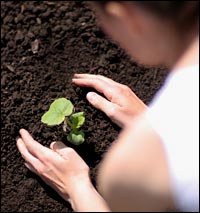Dear Umbra,
My simple understanding of global warming is that we are introducing long-buried carbon dioxide into the atmosphere. This is shifting the balance, leading to a host of undesirable issues. CO2 is consumed by plants, so here’s my thought: Could we grow crops that consume a lot of CO2 (I’m thinking bamboo here, which grows really quickly) and then bury them, effectively taking the CO2 they’ve consumed out of the atmosphere and the equation (at least for a while)?
Randy
Kansas City, Mo.
Dearest Randy,
Nice summary of global warming. “Undesirable issues,” indeed. Green plants take up carbon into their greenbits and keep it there until they degrade — even lumber is still sequestering CO2. So planting plants is great for you and me in the What We Can Do category. We just need to edit your bamboo idea, and you’ll be ready to go.

Grow forth and multiply.
Photo: iStockphoto.
Plants are carbon “sinks,” meaning that CO2 is absorbed and stored by vegetative biomass. Helpful vegetation includes all sorts of forest and grasslands, plus healthy soils that store organic material. A healthy, diverse forest can sequester carbon at almost 2.5 tons per acre, by one estimate. In the U.S., this plant-related carbon storage is retarding the impact of our fossil-fuel production, absorbing the equivalent of 13 percent of our greenhouse-gas emissions. On the other hand, by some estimates, almost 20 percent of worldwide CO2 emissions are released during destruction of forests and grasslands.
Although we seem to be sure that forests are sheltering us from our own idiocy, there are aspects of the system that remain mysterious (imagine — we don’t completely understand nature). Two Science questions are: which types of forest or grassland do the job best; and, frighteningly, when will human carbon generation overload our forest storage unit. Reasons for this last would be climatic shifts themselves (hotter, drier, wetter), resulting in less carbon capacity in plants. So we can’t just plant trees and keep doing whatever else we want, but we should plant trees. One caveat is to use appropriate trees for your area. Sweeping generalizations are dangerous, but I hazard that bamboo is inappropriate for Missouri. The other caveat is that cutting a tree down in order to bury it would defeat part of the purpose. Why let plants degrade when you can work toward building a long-lived, diverse forest or prairie instead? It is the entire forest — mature, immature, and midlife trees and all their understory friends — that stores carbon, so planting trees and leaving them mostly alone seems the best course. As you work on your own carbon sink at home, look to your local cooperative extension office for appropriate trees.
In terms of activism beyond your own forest, you can support local efforts to protect or restore Missouri’s carbon sinks. Ecologists look at several ways to do this, including less-destructive resource extraction (gentler forestry, you could call it); afforestation (putting forests where none were); and reforestation.
That’s right, it’s time to join a volunteer tree-planting event. If you are truly passionate about forest carbon sequestration, getting in on the ground level — har har — will be the way to learn much, much more about it. Look for events via your local Sierra Club, Audubon Society, or Arbor Day Foundation. Hey, check it out — Arbor Day is April 28. My timing is almost impeccable.
Leafily,
Umbra


